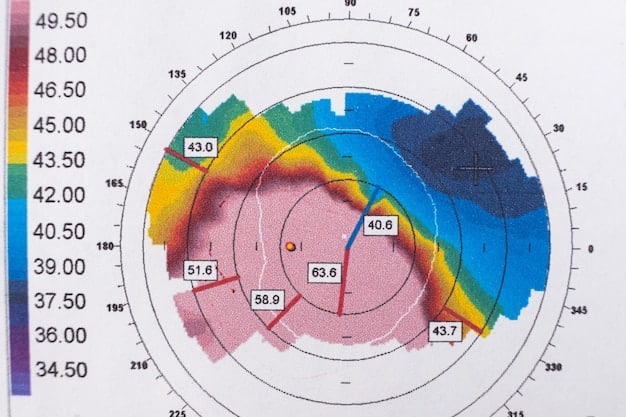AI-Driven Solutions for Opioid Addiction Relapse Prediction & Prevention in US Healthcare

AI’s role in predicting and preventing opioid addiction relapse within the US healthcare system involves leveraging machine learning to identify high-risk individuals, personalize treatment plans, and provide timely interventions, ultimately aiming to reduce relapse rates and improve patient outcomes.
The opioid crisis continues to devastate communities across the United States, and relapse remains a significant hurdle in addiction recovery. AI’s role in predicting and preventing opioid addiction relapse: A US healthcare perspective offers hope for more effective interventions and improved patient outcomes.
Understanding the Opioid Crisis and the Challenge of Relapse
The opioid crisis in the US has reached epidemic proportions, causing immense suffering and straining healthcare resources. Relapse is a common and devastating occurrence for individuals struggling with opioid addiction, highlighting the urgent need for innovative solutions.
Addressing this complex issue requires a multi-faceted approach that combines pharmacological treatments, behavioral therapies, and robust support systems. However, even with these interventions, relapse rates remain high, emphasizing the need for more precise and personalized strategies.
The Scope of the Opioid Crisis in the US
The sheer scale of the opioid crisis is staggering, with hundreds of thousands of lives lost and countless families affected. Understanding the epidemiology and societal impact is crucial for developing effective prevention and treatment strategies.
Factors Contributing to Opioid Relapse
Opioid relapse is influenced by a complex interplay of factors, including genetic predispositions, environmental stressors, and psychological vulnerabilities. Identifying and addressing these factors is essential for personalized relapse prevention.
- Genetic factors can influence an individual’s susceptibility to addiction and relapse.
- Environmental cues and social pressures can trigger cravings and increase the risk of relapse.
- Psychological factors, such as trauma, depression, and anxiety, can contribute to relapse vulnerability.
By recognizing the intricate web of influences that contribute to opioid relapse, healthcare professionals can develop targeted interventions that address the specific needs of each patient. This personalized approach is crucial for improving long-term recovery outcomes.
In conclusion, the opioid crisis demands innovative and effective solutions to combat the challenges of relapse. By understanding the scope of the crisis and the complex factors contributing to relapse, healthcare professionals can leverage AI technologies to develop personalized prevention strategies and improve patient outcomes.
How AI Can Predict Opioid Addiction Relapse
Artificial intelligence (AI) offers powerful tools for predicting opioid addiction relapse by analyzing vast datasets and identifying patterns that may be imperceptible to human clinicians. Machine learning algorithms can assess individual risk factors and forecast the likelihood of relapse, enabling proactive interventions.
These predictive models can incorporate a wide range of data points, including patient demographics, medical history, substance use patterns, and psychosocial factors, to generate personalized risk assessments. By identifying high-risk individuals early on, healthcare providers can tailor treatment plans and provide targeted support to prevent relapse.

Machine Learning Algorithms for Relapse Prediction
Machine learning algorithms, such as neural networks and support vector machines, are particularly well-suited for analyzing complex datasets and identifying subtle patterns that can predict relapse risk. These algorithms can continuously learn and improve their accuracy as more data becomes available.
Data Sources for AI-Driven Prediction Models
AI-driven prediction models rely on a variety of data sources, including electronic health records, prescription drug monitoring programs, and patient-reported outcomes. Integrating these data sources can provide a comprehensive picture of an individual’s risk profile.
- Electronic health records contain valuable information about a patient’s medical history, substance use patterns, and treatment outcomes.
- Prescription drug monitoring programs track opioid prescriptions and identify individuals who may be at risk of overdose or addiction.
- Patient-reported outcomes provide insights into a patient’s psychosocial well-being and their adherence to treatment plans.
By harnessing the power of AI and machine learning, healthcare systems can identify individuals at high risk of opioid addiction relapse and provide timely interventions to prevent this devastating occurrence. The ability to predict relapse with greater accuracy can significantly improve patient outcomes and reduce the burden of the opioid crisis.
In summary, AI’s predictive capabilities offer a promising avenue for addressing the challenge of opioid addiction relapse. By leveraging machine learning algorithms and integrating diverse data sources, healthcare providers can identify high-risk individuals and implement proactive strategies to prevent relapse, leading to improved patient outcomes and a more effective response to the opioid crisis.
AI-Powered Tools for Preventing Opioid Relapse
Beyond prediction, AI can also play a crucial role in preventing opioid relapse by providing personalized interventions and support. AI-powered tools, such as mobile apps and virtual coaches, can offer continuous monitoring, early intervention support, and tailored behavioral therapies, enhancing the effectiveness of traditional treatment approaches.
These tools can track various indicators of relapse risk, such as cravings, mood changes, and social triggers, and provide real-time feedback and support to help individuals stay on track with their recovery goals. By offering personalized guidance and support, AI-powered tools can empower individuals to manage their addiction and prevent relapse.

Mobile Apps for Relapse Prevention
Mobile apps can provide convenient and accessible support for individuals in recovery from opioid addiction. These apps can offer a range of features, including medication reminders, relapse prevention strategies, and access to peer support networks.
Virtual Coaches and Chatbots for Personalized Support
Virtual coaches and chatbots can provide personalized support and guidance to individuals struggling with opioid addiction. These AI-powered tools can offer tailored behavioral therapies, motivational interviewing, and crisis intervention support.
- Virtual coaches can provide personalized feedback and encouragement to help individuals stay on track with their recovery goals.
- Chatbots can offer instant access to information and support, helping individuals cope with cravings and manage triggers.
- AI-powered tools can connect individuals with peer support networks, fostering a sense of community and shared experience.
AI-powered tools offer a valuable complement to traditional treatment approaches for opioid addiction, providing continuous monitoring, personalized support, and tailored interventions. By empowering individuals to manage their addiction and prevent relapse, these tools can improve long-term recovery outcomes and reduce the burden of the opioid crisis.
In conclusion, AI-powered tools hold immense potential for preventing opioid relapse by providing personalized support and interventions. Mobile apps and virtual coaches can offer continuous monitoring, tailored behavioral therapies, and connections to peer support networks, empowering individuals to manage their addiction and achieve long-term recovery.
Integrating AI into US Healthcare Systems for Addiction Treatment
Integrating AI into US healthcare systems for addiction treatment involves overcoming technical, ethical, and regulatory challenges. To realize the full potential of AI in combating opioid addiction relapse, healthcare providers, policymakers, and technology developers must work together to ensure that AI-driven solutions are safe, effective, and equitable.
This integration requires careful planning and execution, as well as ongoing monitoring and evaluation. It is essential to address concerns about data privacy, algorithmic bias, and the potential displacement of human clinicians. By addressing these challenges proactively, healthcare systems can harness the power of AI to improve addiction treatment and reduce the devastating impact of the opioid crisis.
Technical Challenges of AI Integration
Integrating AI into healthcare systems requires overcoming technical challenges related to data interoperability, algorithm validation, and system maintenance. Ensuring that AI systems are accurate, reliable, and secure is crucial for building trust and promoting adoption.
Ethical Considerations in AI for Addiction Treatment
The use of AI in addiction treatment raises important ethical considerations, including data privacy, algorithmic bias, and the potential for discrimination. Healthcare systems must ensure that AI systems are used ethically and responsibly, with appropriate safeguards in place to protect patient rights.
- Data privacy is paramount, and healthcare systems must ensure that patient data is protected from unauthorized access and misuse.
- Algorithmic bias can lead to unfair or discriminatory outcomes, and healthcare systems must work to identify and mitigate bias in AI systems.
- The potential for discrimination must be addressed proactively, and healthcare systems must ensure that AI systems are used to promote equity and inclusion.
Integrating AI into US healthcare systems for addiction treatment requires careful consideration of the technical, ethical, and regulatory challenges involved. By addressing these challenges proactively, healthcare systems can harness the power of AI to improve addiction treatment and reduce the devastating impact of the opioid crisis.
In summary, integrating AI into US healthcare systems for addiction treatment requires a collaborative effort to overcome technical, ethical, and regulatory challenges. By ensuring that AI-driven solutions are safe, effective, and equitable, healthcare providers can leverage the power of AI to improve addiction treatment and reduce the devastating impact of the opioid crisis.
The Future of AI in Opioid Addiction Treatment
The future of AI in opioid addiction treatment holds tremendous promise. As AI technology continues to evolve, we can expect to see even more sophisticated tools and interventions that address the complex challenges of addiction and relapse. From personalized medication management to virtual reality-based therapies, AI has the potential to revolutionize the way we approach addiction treatment.
Looking ahead, it is essential to continue investing in research and development to explore the full potential of AI in addiction treatment. By fostering collaboration between researchers, clinicians, and technology developers, we can accelerate the development and implementation of innovative AI-driven solutions that improve patient outcomes and reduce the burden of the opioid crisis.
Personalized Medication Management with AI
AI can be used to personalize medication management for individuals in recovery from opioid addiction. By analyzing patient data and predicting individual responses to different medications, AI can help clinicians optimize treatment plans and minimize side effects.
Virtual Reality-Based Therapies for Addiction
Virtual reality (VR) technology offers new possibilities for addiction treatment. VR-based therapies can simulate real-world scenarios that trigger cravings and provide individuals with opportunities to practice coping skills in a safe and controlled environment.
- VR-based therapies can help individuals identify and manage triggers that lead to relapse.
- VR simulations can provide opportunities to practice coping skills, such as relaxation techniques and cognitive restructuring.
- VR technology can create immersive and engaging experiences that enhance the effectiveness of traditional therapies.
The future of AI in opioid addiction treatment is bright, with the potential for personalized medication management, virtual reality-based therapies, and other innovative interventions. By continuing to invest in research and development, we can unlock the full potential of AI to transform addiction treatment and improve patient outcomes.
In conclusion, the future of AI in opioid addiction treatment is filled with promise. Personalized medication management and virtual reality-based therapies are just two examples of the innovative AI-driven solutions that could revolutionize the way we approach addiction treatment, ultimately improving patient outcomes and reducing the burden of the opioid crisis.
Case Studies: AI Success Stories in Opioid Relapse Prevention
While the widespread adoption of AI in opioid relapse prevention is still relatively new, several promising case studies demonstrate the potential of this technology. These early success stories highlight the impact that AI can have on patient outcomes and the reduction of relapse rates.
These case studies offer valuable insights into the practical applications of AI in addiction treatment and provide a glimpse of the future. By learning from these successes, healthcare providers can better understand how to implement AI-driven solutions and maximize their benefits for patients struggling with opioid addiction.
AI-Powered Prediction Model Reduces Relapse Rates
One case study involved the implementation of an AI-powered prediction model in a community-based addiction treatment program. The model analyzed patient data to identify individuals at high risk of relapse, allowing clinicians to provide targeted interventions and support.
Mobile App Improves Medication Adherence and Reduces Cravings
Another case study focused on the use of a mobile app that provides medication reminders, relapse prevention strategies, and access to peer support networks. The app helped individuals improve their medication adherence, manage cravings, and stay connected with their support system.
- The mobile app sent automated reminders to ensure that individuals took their medication as prescribed.
- The app provided access to relapse prevention strategies, such as mindfulness exercises and cognitive restructuring techniques.
- The app connected individuals with peer support networks, fostering a sense of community and shared experience.
These case studies demonstrate the potential of AI to improve patient outcomes and reduce relapse rates in opioid addiction treatment. By learning from these successes, healthcare providers can better understand how to implement AI-driven solutions and maximize their benefits for patients.
In summary, case studies highlighting the successful implementation of AI in opioid relapse prevention offer valuable insights into the practical applications of this technology. These early successes demonstrate the potential of AI to improve patient outcomes, reduce relapse rates, and transform the landscape of addiction treatment.
| Key Point | Brief Description |
|---|---|
| 🤖 AI Prediction | AI algorithms analyze data to predict opioid addiction relapse risk. |
| 📱 Mobile Apps | Mobile apps provide support with medication reminders & relapse prevention. |
| 👩⚕️ AI Integration | Integrating AI ethically into US healthcare for addiction treatment. |
| 💡 Future of AI | Future AI applications in opioid treatment include personalized support. |
Frequently Asked Questions
▼
AI algorithms analyze patient data, like medical history and usage patterns, to identify patterns that predict relapse risks better than traditional methods.
▼
AI uses electronic health records, prescription data, and patient-reported results to comprehensively analyze an individual’s risk factors for opioid relapse.
▼
Yes, biases in data, privacy and data security, and the possibility of discrimination need to be addressed to ensure fair and secure AI use in addiction treatment.
▼
VR provides simulations in safe settings to manage triggers and practice effective coping strategies without the risk of relapse in real-life situations.
▼
Future steps include better personalized treatment for medication and mental health, enhanced by detailed data analysis, which promotes more effective recovery outcomes.
Conclusion
In conclusion, AI offers a transformative approach to predicting and preventing opioid addiction relapse within the US healthcare system. By leveraging machine learning algorithms, integrating diverse data sources, and developing personalized interventions, AI can empower healthcare providers to improve patient outcomes and address the devastating impact of the opioid crisis.





